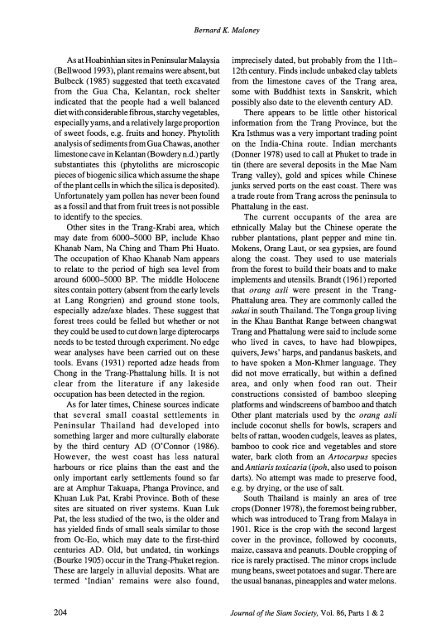The Journal of the Siam Society Vol. LXXXVI, Part 1-2 ... - Khamkoo
The Journal of the Siam Society Vol. LXXXVI, Part 1-2 ... - Khamkoo
The Journal of the Siam Society Vol. LXXXVI, Part 1-2 ... - Khamkoo
You also want an ePaper? Increase the reach of your titles
YUMPU automatically turns print PDFs into web optimized ePapers that Google loves.
Bernard K. Maloney<br />
As at Hoabinhian sites in Peninsular Malaysia<br />
(Bellwood 1993), plant remains were absent, but<br />
Bulbeck (1985) suggested that teeth excavated<br />
from <strong>the</strong> Gua Cha, Kelantan, rock shelter<br />
indicated that <strong>the</strong> people had a well balanced<br />
diet with considerable fibrous, starchy vegetables,<br />
especially yams, and a relatively large proportion<br />
<strong>of</strong> sweet foods, e.g. fruits and honey. Phytolith<br />
analysis <strong>of</strong> sediments from Gua Chawas, ano<strong>the</strong>r<br />
limestone cave in Kelantan (Bowdery n.d.) partly<br />
substantiates this (phytoliths are microscopic<br />
pieces <strong>of</strong> biogenic silica which assume <strong>the</strong> shape<br />
<strong>of</strong> <strong>the</strong> plant cells in which <strong>the</strong> silica is deposited).<br />
Unfortunately yam pollen has never been found<br />
as a fossil and that from fruit trees is not possible<br />
to identify to <strong>the</strong> species.<br />
O<strong>the</strong>r sites in <strong>the</strong> Trang-Krabi area, which<br />
may date from 6000-5000 BP, include Khao<br />
Khanab Nam, Na Ching and Tham Phi Huato.<br />
<strong>The</strong> occupation <strong>of</strong> Khao Khanab Nam appears<br />
to relate to <strong>the</strong> period <strong>of</strong> high sea level from<br />
around 6000-5000 BP. <strong>The</strong> middle Holocene<br />
sites contain pottery (absent from <strong>the</strong> early levels<br />
at Lang Rongrien) and ground stone tools,<br />
especially adze/axe blades. <strong>The</strong>se suggest that<br />
forest trees could be felled but whe<strong>the</strong>r or not<br />
<strong>the</strong>y could be used to cut down large dipterocarps<br />
needs to be tested through experiment. No edge<br />
wear analyses have been carried out on <strong>the</strong>se<br />
tools. Evans (1931) reported adze heads from<br />
Chong in <strong>the</strong> Trang-Phattalung hills. It is not<br />
clear from <strong>the</strong> literature if any lakeside<br />
occupation has been detected in <strong>the</strong> region.<br />
As for later times, Chinese sources indicate<br />
that several small coastal settlements in<br />
Peninsular Thailand had developed into<br />
something larger and more culturally elaborate<br />
by <strong>the</strong> third century AD (O'Connor (1986).<br />
However, <strong>the</strong> west coast has less natural<br />
harbours or rice plains than <strong>the</strong> east and <strong>the</strong><br />
only important early settlements found so far<br />
are at Amphur Takuapa, Phanga Province, and<br />
Khuan Luk Pat, Krabi Province. Both <strong>of</strong> <strong>the</strong>se<br />
sites are situated on river systems. Kuan Luk<br />
Pat, <strong>the</strong> less studied <strong>of</strong> <strong>the</strong> two, is <strong>the</strong> older and<br />
has yielded finds <strong>of</strong> small seals similar to those<br />
from Oc-Eo, which may date to <strong>the</strong> first-third<br />
centuries AD. Old, but undated, tin workings<br />
(Bourke 1905) occur in <strong>the</strong> Trang-Phuket region.<br />
<strong>The</strong>se are largely in alluvial deposits. What are<br />
termed 'Indian' remains were also found,<br />
imprecisely dated, but probably from <strong>the</strong> 11th-<br />
12th century. Finds include unbaked clay tablets<br />
from <strong>the</strong> limestone caves <strong>of</strong> <strong>the</strong> Trang area,<br />
some with Buddhist texts in Sanskrit, which<br />
possibly also date to <strong>the</strong> eleventh century AD.<br />
<strong>The</strong>re appears to be little o<strong>the</strong>r historical<br />
information from <strong>the</strong> Trang Province, but <strong>the</strong><br />
Kra Isthmus was a very important trading point<br />
on <strong>the</strong> India-China route. Indian merchants<br />
(Donner 1978) used to call at Phuket to trade in<br />
tin (<strong>the</strong>re are several deposits in <strong>the</strong> Mae Nam<br />
Trang valley), gold and spices while Chinese<br />
junks served ports on <strong>the</strong> east coast. <strong>The</strong>re was<br />
a trade route from Trang across <strong>the</strong> peninsula to<br />
Phattalung in <strong>the</strong> east.<br />
<strong>The</strong> current occupants <strong>of</strong> <strong>the</strong> area are<br />
ethnically Malay but <strong>the</strong> Chinese operate <strong>the</strong><br />
rubber plantations, plant pepper and mine tin.<br />
Mokens, Orang Laut, or sea gypsies, are found<br />
along <strong>the</strong> coast. <strong>The</strong>y used to use materials<br />
from <strong>the</strong> forest to build <strong>the</strong>ir boats and to make<br />
implements and utensils. Brandt ( 1961) reported<br />
that orang asli were present in <strong>the</strong> Trang<br />
Phattalung area. <strong>The</strong>y are commonly called <strong>the</strong><br />
sakai in south Thailand. <strong>The</strong> Tonga group living<br />
in <strong>the</strong> Khau Banthat Range between changwat<br />
Trang and Phattalung were said to include some<br />
who lived in caves, to have had blowpipes,<br />
quivers, Jews' harps, and pandanus baskets, and<br />
to have spoken a Mon-Khmer language. <strong>The</strong>y<br />
did not move erratically, but within a defined<br />
area, and only when food ran out. <strong>The</strong>ir<br />
constructions consisted <strong>of</strong> bamboo sleeping<br />
platforms and windscreens <strong>of</strong> bamboo and thatch<br />
O<strong>the</strong>r plant materials used by <strong>the</strong> orang asli<br />
include coconut shells for bowls, scrapers and<br />
belts <strong>of</strong> rattan, wooden cudgels, leaves as plates,<br />
bamboo to cook rice and vegetables and store<br />
water, bark cloth from an Artocarpus species<br />
and Antiaris toxic aria ( ipoh, also used to poison<br />
darts). No attempt was made to preserve food,<br />
e.g. by drying, or <strong>the</strong> use <strong>of</strong> salt.<br />
South Thailand is mainly an area <strong>of</strong> tree<br />
crops (Donner 1978), <strong>the</strong> foremost being rubber,<br />
which was introduced to Trang from Malaya in<br />
1901. Rice is <strong>the</strong> crop with <strong>the</strong> second largest<br />
cover in <strong>the</strong> province, followed by coconuts,<br />
maize, cassava and peanuts. Double cropping <strong>of</strong><br />
rice is rarely practised. <strong>The</strong> minor crops include<br />
mung beans, sweet potatoes and sugar. <strong>The</strong>re are<br />
<strong>the</strong> usual bananas, pineapples and water melons.<br />
204<br />
<strong>Journal</strong> <strong>of</strong> <strong>the</strong> <strong>Siam</strong> <strong>Society</strong>, <strong>Vol</strong>. 86, <strong>Part</strong>s 1 & 2

















